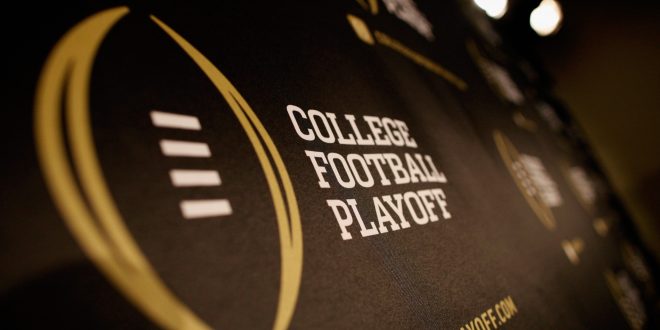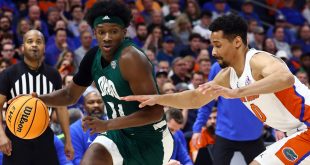The field for the College Football Playoff is set with no real surprises. After demolishing Georgia in the SEC Championship Game, LSU jumps to No. 1 in the country. They will face the Big 12 Champion Oklahoma Sooners, who checked in at No. 4. Ohio State falls to No. 2 after having to rally in the second half to top Wisconsin in the Big 10 Championship Game. The Buckeyes face the defending national champion Clemson Tigers, who throttled Virginia to win its 28th straight game.
The eye test and resume for each of the four Playoff teams support their bid to the top four. However, does the advanced statistics support the committee’s decision? ESPN Gainesville along with the Sports Statistics Club (Christopher Cavaliere, Tyler Bolleter Alex Marty, and Brenden Neely) broke down the analytics of the top playoff contenders.
The Sports Analytics Club takes a two-pronged approach focusing on offensive and defensive lines compared with general offensive and secondary play. These numbers contribute to an overall power ranking score, which shows how dominant each team is on both sides of the ball.
It all comes down to this #CFBPlayoff pic.twitter.com/V6UzxpWLl3
— SportsCenter (@SportsCenter) December 8, 2019
LSU
LSU finished first in the rankings for the College Football Playoff. This is due in large part to the team’s explosive offense, led by quarterback Joe Burrow. Burrow is considered to be the front runner for the Heisman Trophy and the numbers back it up. LSU’s adjusted offensive efficiency rating is 6.56, the highest out of all the other four Playoff teams. The rating is adjusted based on strength of schedule.
It all starts up-front for the Tiger offense on the offensive line. LSU’s standard down sack rate for all passing attempts is just 5.7 percent.
The LSU defense this season has been suspect at times. LSU’s adjusted defensive efficiency rating is -1.158. However, this is still the second-highest out of the top four teams. The Tigers have allowed touchdowns on 22 percent of drives this season, which ranks third among the four semifinal contenders.
Ohio State
Similar to the Tigers, the Ohio State Buckeye offense is explosive. Ohio State’s offensive efficiency rating of 6.091 is slightly below the Tigers’ rating. However, the Buckeyes are more efficient in scoring touchdowns than the Tigers. Ohio State has scored touchdowns on 56.2 percent of its drives this season.
You can’t talk Ohio State this season without talking about its defense. Led by Heisman hopeful defensive lineman Chase Young, the Buckeye defensive front is a nightmare for opponents to gameplan for. The Buckeyes have the highest adjusted defensive line pass defense efficiency rating out of the four semifinalists at 3.3521. This rating takes into account sack rates on both passing and standard downs. In fact, Ohio State’s sack rate of 13.2 percent is also the highest in the Playoff. Ohio State also holds the lowest adjusted defensive line run defense efficiency rating at 0.2898. This rating factored in the rate of runs stopped at or behind the line of scrimmage and preventing touchdowns on third and short.
Clemson
After winning the national championship in 2018, Clemson showed no signs of a championship hangover in 2019. It all starts with the star of last year’s title game victory, quarterback Trevor Lawrence. The talent around Lawrence is undeniable. That talent starts on the offensive line. The Tigers’ sack rate is just 2.4 percent, which is the lowest among the four semifinalists.
On the other side of the ball, Clemson’s defense has dominated opponents. Their adjusted defensive efficiency rating is -2.352, second only to Ohio State. However, the Tigers’ unadjusted defensive efficiency rating is the lowest at .4370. This is not taking the strength of schedule into account. The Tigers’ lack of competition in the ACC has been the biggest criticism this season. According to ESPN FPI, the Tigers have the 56th hardest schedule in the country.
Oklahoma
Oklahoma needed help to get into the Playoff picture. However, they don’t need help justifying their inclusion in one of the national semifinal games. Oklahoma’s high powered offense is led by quarterback Jalen Hurts. The Alabama transfer is making his fourth straight appearance in the College Football Playoff. Oklahoma has the second-highest unadjusted offensive efficiency rating at 2.201, slightly behind LSU at 2.316. Head coach Lincoln Riley’s offense is predicated on running the ball, specifically with the option. This is evident when looking at the Sooners’ offensive numbers. The Sooner’s power success rate is the highest of the four teams at 89.5 percent. The Oklahoma offensive line adjusted efficiency rate is also the highest at 2.1712.
The Achilles heel for the Sooners is their defense. The adjusted defensive efficiency rating for the Sooners is 2.265, the highest total of the four teams. 50.5 percent of opponent’s offensive drives end in touchdowns against Oklahoma.
Power Ratings
The power ratings are based on the adjusted defensive and offensive line ratings along with adjusted defense and offense efficiency ratings.
Based on the power ratings, the top four is Ohio State (13.774), Clemson (12.789), LSU (9.624), and Oklahoma (5.926). There’s no denying that Ohio State and Clemson have been two of the most dominant teams this season. The two have blown teams out on almost a weekly basis. However, Ohio State’s strength of schedule is 26th while Clemson’s is 56th. LSU, on the other hand, has the 10th toughest schedule in the country with four wins coming against teams in the top 15.
 ESPN 98.1 FM / 850 AM WRUF ESPN 98.1 FM / 850 AM WRUF
ESPN 98.1 FM / 850 AM WRUF ESPN 98.1 FM / 850 AM WRUF




